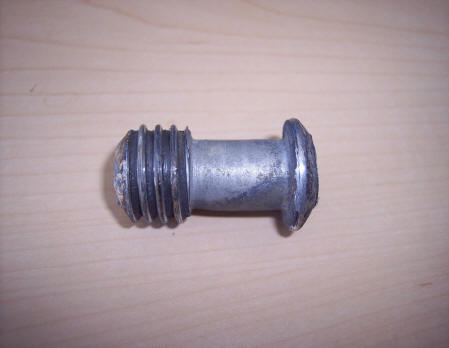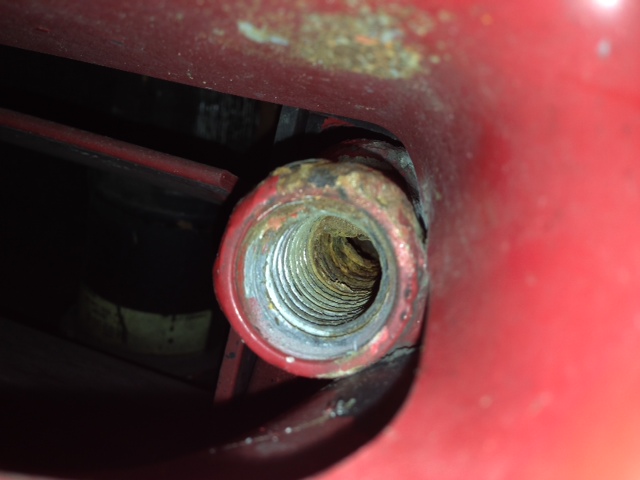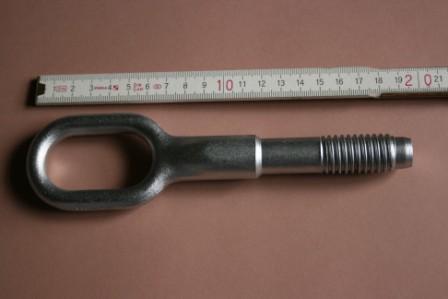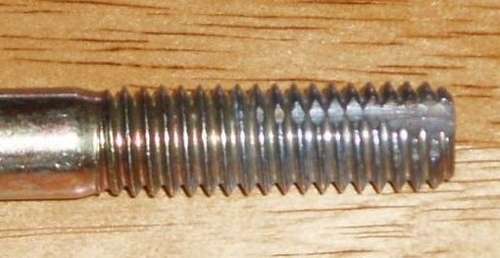
This one of the few pictures that exist of an extracted tow eye...


You must also be aware that the tow eye is open on the front but also on the back, and closing the front may cause water and debris to enter at the read even accelerating the corrosion process. I recommend keeping it open and use anti corrosion stuff like Mike Sanders wax.

Guess where most of the corrosion comes from? (who designed this ????)
Theo
===

Hi all,
My 1988 928s4 has a tow-eye at the front as all of them do I believe.
The opening where it screws in is normally covered by a plug that is made of
aluminum. It takes a hex-key wrench to unscrew it. Then you
can screw in the tow eye from the tools kit.
Well.... it seemed like a good idea of Porsche at the time they built the car,
but after 17 years the plug is stuck in the threads. I tried everything to
get it out. Corrosion gets a whole different meaning at this bitch. After some
time I decided not to give up and drill the plug out. Since its aluminum
its easy. But the remaining part is still frozen into the threads and needs to
come out too. Its just 0.3mm or so, but it does block the tow-eye thread.
I'm looking for the right trick to clean the threads now. Looks like a M20x3mm
thread that is not totally straight in diameter (cone?), so its some special
thread they used. It makes me wonder why the hell they did not use a M20x2.5mm
which is industry standard.... I can get a tool for that one.
Any idea's?
Theo
=========
Ohhh. This is a classic in the 928. I wonder how many people would
like to meet the person responsible for this design and make a dent in
the head...
I've almost drilled it out of both my cars, but neither is finished.
Porsche finally saw reason, and in later GTS'es, replaced this with a
rubber pacifier instead.
928 722 107 01. About $3. Interestingly the rubber GTS part has the same part #
as the alloy S4/GT part
Johnny
=========
Johnny,
I've done it now. Phew. Its clear and out.
Jim Morehouse' suggestion made me think again and maybe I still needed to grind
the aluminum somewhat further down.
This is a quick step by step procedure:
With a lot of patience it finally clears and the tow-eye will fit in.
Now I'm looking to find something suitable for a plug to prevent water from
entering and corroding it all up again.
For those of you who have a plug that still works: try it every year and prevent
this terrible corrosion. What must Porsche have been thinking while designing
this......
Theo
'88 928s4 cherry red
The Netherlands
http://928gts.jenniskens.eu
=========
Hi Theo
Drill the centre out with a drill slightly smaller than the internal
diameter of the threads so you don't damage the steel threads. Then
using a milling bit in a dremel clean out as much of the remaining
Aluminum form above the threads and into the threads if you have a
milling bit small enough. Do both of the above gently so the
drill/milling bits only cut alu not steel.
Pick out as much of the threads of alu as you can using picks and
scrapers and old bent screwdrivers.
Finally file a groove into the towing eye ( so it looks a bit like a
thread cutting tap) but file off the beginnings of the first thread on
the eye so that the thread starts at the groove you just filed with a
square edge - ie end of the thread is a flat plane aligned radially to
the central axis of the towing eye. wind the towing eye into the hole
in the front of the car and the remaining alu will be pushed out of the
female threads by the flat face of the male thread you filed above.

thanks (not) for reminding me that I need to do this to Rhondas GT
Cheers
Jon in NZ
===========
Theo. I've already come as far as drilling. I'm now at the point where I need
something else for that last bit.
Dremel, toothpick and brush... Hmm... I'll have to get it first, but it's
probably good suggestions...
As for something else to plug in there - just go to Porsche, and order
928.722.197.01.
I already have two of those waiting for when I have managed to clean the socket
out.
(It's the part Porsche replaced that aluminum plug with on the GTS,
*finally*.)
Johnny
===========
Theo,
My pragmatic approach to these problems is to find out what thread Porsche used
on the screw eye. I doubt they invented a screw thread for this application.
It's probably a metric R 1/4 keg type thread which is the metric equivalent to
BSPT (British Standard Pipe Tapered). Once you have identified the thread, you
should be able to purchase a tap in that size for a few dollars. If a tap is
difficult to find, a substitute can be made by any machinist with a screw
cutting lathe with a taper attachment. One does not need to fabricate anything
as precision as a real tap in order to clean out threads. Just make a hardenable
steel screw that matches the thread on the end of the eye, cut a radial relief
in it to form a cutting edge, harden it, and use it like a tap to clean out
residual aluminum that the drilling process did not remove. It's only a little
complicated, and much easier than the hours spent with a dremel tool and picks.
Besides you can share the tap with your 928 buddies.
Tom Salzer
===========
Tom
I forget who but someone on the UK list did price up getting a M20x3 tap made
(bear in mind the thread is a strange/weird profile not your normal 60deg or
75deg) It turned (excuse the pun) out a lot cheaper (approx $20 versus 200) to
buy another tow eye and use the modified original as a tap.
Jon in NZ
probably pay someone here to file a tap out by hand for $200!
==========
All the recent discussion about tow eyes reminded me that I did not inherit
one with my 87. I thought I’d temporarily transfer the one from my 84, and then
put one on my list for purchase. But when I tested it on the 87, I saw it was
the wrong one (thread too small).
So I checked the PET, and found there’s an early version (928.722.101.03) and a
later version (928.722.101.05), but it said the breakpoint was between 83 and
84. So then I checked the eye bolt on the 84, and found it is too small for the
84!
So I’ve been driving around for over seven years with the wrong tow eye in that
car! LOL. Luckily I’ve never needed to use it. It’s the one I got with the car,
so I don’t know the story...
So now I’m shopping for some newer tow eyes, and I found that there’s another
new one that fits lots of other Porsches (996.721.151.00). From the pictures, it
looks just like the newer 928 one, with the larger thread. Any one ever try one
of these, or know if it will work on a 928?
They’re abundantly available around the web for cheap.
BTW, none of the six holes on my three cars have any metal plugs threaded into
them. They are all open, and they look fine (clean, and corrosion free). One of
my S4’s has the rubber fill plugs with the little pull handles on them.
Mit freundlichem Gruss, Mark in Atlanta
=========
The tow eyes (abschleppoese) are available on eBay (Porsche PN#
996.721.151.00) for about US$18.00. They appear to be steel forgings that have
the thread cut after forging. They also appear to have a parallel thread form
instead of tapered threads, as has been suggested. If that is the case, then a
spare tow eye can have an radial cut made on a milling machine, and be used as a
tap to remove pieces of a drilled out plug. An optional step would be to case
harden the threads after the milling cut. This would assure long tap life for
many plug removals. If someone wants to send me a tow eye, I will convert it
into a tap for them free of charge, or make a new tap depending on the actual
pitch of the threads. Scaling the ones on eBay, it looks like the pitch is
somewhere between 3 and 4 mm. I've that real men don't waste their time picking
at pieces of drilled out plugs.
Tom Salzer
========
There are two variants that exist as two eye: 1987 -1995 ± 20mm thread
diameter,
and ±13mm 1979-1986. The thread is likely Whitworth 8G1
Theo
========
It threads into the steel tube that is welded into the frame rail.
The "allen" key in the toolkit is supposed to be able to undo the plug -
HAHAHAHA ROFL.
The thread is a Knuckle thread (best match I have found) as per attached link
http://www.gewinde-normen.de/en/knuckle-thread-din-405.html
IIRC the thread is RD22x1/8"
Thread Size-Nominal Diameter-mm Bolt Thread Minor Diameter- mm Nut Thread Minor
Diameter- mm Pitch- mm TPI
Rd 22 x 1/8" 22,318 18,825 19,142 3,175 8
The only way I have found to remove the plug involves a drill - up to about 18mm
dia should be OK then a dremel with a carbide burr alternating with small picks
to grind/pick out the little bits of alu from between the steel threads of the
tube welded into the body. A suitable plug to close the whole up afterwards is
one of the rubber bungs that you find at bicycle stores normally used to plug
the ends of racing bike handlebars. I just sprayed the inside of the tube with
chain wax.
__________________
Jon in OZ
Hi,
I've done a few of these now. It is a PITA every time. Forget about unscrewing
it if it has been stuck for some years. The bolt is so badly corroded that it
breaks after 4mm, leaving the remainder inside the hole. I've seen this happen
every time. I even tried hammering the plug-bolt from the side with a chisel. No
movement at all.
Best is to drill it out, use the hex-key slot to center, and try not to damage
the threads. From there onwards use a dremel tool and a small grinder to
carefully remove the remaining aluminum, and just like Jon said: a steel
toothpick to peel the threads of the bolt out. It works ok. Takes an hour or so
if you're quick.
If you do this carefully you will not need a thread cutter in this exotic size
to clean out the threads.
regards,
Theo
--------
Here's a page that specifies the thread cutter used for the tow hook
Rundgewinde Rd 20 x 1/8" nach DIN 405
Gewindeschneider gibt`s hier!
http://www.hahnreiter.de/docs/katalog_neu.pdf
Schönen Gruß,
Armin
-------
The part you need to properly close the opening for the tow hook (and you might consider closing both sides) is:
928.722.107.01 VERSCHLUSSSTOPFEN ABSCHLEP 2,00 € 2
